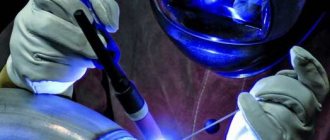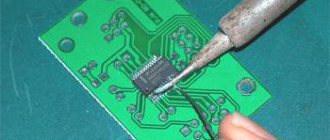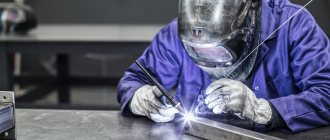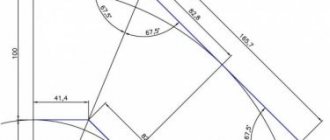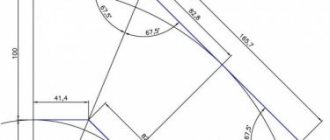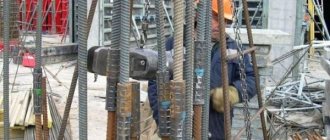There are a wide variety of types and types of welding. But they all have one thing in common - the need to use an electric arc, without which the formation of a seam is impossible. And among the wide variety, MIG/MAG welding using gas is one of the most popular.
This type of welding is simple and easy to use, it is suitable for both a novice welder and an experienced welder. Using instant welding, you can easily weld different types of metals, with different thicknesses and any complexity of seams. In this article we will tell you what MIG is and what are the features of shielded gas welding.
Definition
MIG/MAG welding (also known as electric arc welding in a gas environment, arc welding in a shielding gas environment, also known as magic and mig welding, GMAW) is semi-automatic, manual and automatic welding in a shielding gas environment using the fusion method (GMAW stands for “Gas metal” Arc welding").
Below is a schematic diagram of TIG (tig welding) and MIG/MAG welding. You can compare them and understand what the differences are.
MIG/MAG welding is only possible with direct current, but the polarity can be either direct or reverse. You may have noticed that in addition to MIG, we also use the abbreviation MAG in this article. MAG is also semi-automatic welding, only using carbon dioxide.
With magic welding everything is the same as with mig. Only instead of, say, argon, carbon dioxide is used. It's much cheaper. But with the help of such welding, only parts made of alloy and low-alloy steels can be connected. This is a limitation. So choose professional semi-automatic machines that can work in both MAG and MIG modes. Such devices give you more possibilities; you can use filler wire of any diameter in your work.
Now that we know what mig is, it's time to find out what equipment will be optimal for this method.
Pros and cons of semi-automatic welding
The advantages of semi-automatic welding are obvious, and first of all, it is the high speed of welding work. The length of the welding wire is large, and the volume of gas in the cylinder is also large. Thanks to the automatic supply of wire to the welding site, the speed and scale of welding work increases significantly.
The second plus is associated with a very neat and smooth weld seam. It is impossible to obtain such a seam using manual arc welding, just as it is impossible to effectively weld very thin metal. Semi-automatic welding is the best way to weld thin-walled workpieces, the thickness of which does not exceed 0.5 mm.
The only disadvantage of semi-automatic welding is the need to have shielding gas in a cylinder on hand. It goes without saying that the cylinder needs to be refilled and transported to the welding site, which is not very convenient or simple.
In addition, in some places it is not possible to deliver the cylinder at all. Then semi-automatic welding is carried out using flux-cored wire.
Equipment and components
So, for work we need a standard semi-automatic machine. A set of welding equipment consists of a semi-automatic machine, a transformer (generating current), gas (a reducer must be attached to the cylinder to regulate the pressure), various hoses and cables, a gas torch equipped with an additional filler wire supply system and a feed mechanism.
MIG welding is essentially the same as gas shielded consumable electrode welding. Only instead of an electrode, a filler wire is used here. Most often the wire is made of aluminum. We recommend choosing wire made from the same material that you are going to weld.
The wire is wound onto a drum and automatically fed into the welding zone. The feed speed depends on the wire diameter and the current setting you set. All you have to do is point the torch at the welding zone and press the button.
The wire will begin to feed into the welding zone immediately after the arc is ignited. At the same time, the gas will begin to blow over the weld pool, preventing metal oxidation and the formation of defects. Drawing analogies with other types of welding, in our case the gas plays the role of a coated electrode, as in standard MMA welding. Only here the gas is supplied from the outside, and in MMA welding it is formed when the electrode melts.
What is semi-automatic MIG/MAG welding?
Unlike a conventional MMA inverter, which welds exclusively with a coated consumable electrode, the operating principle of semi-automatic welding is somewhat different. The main consumables here are shielding gas and wire, which is wound on a reel and fed automatically when the semi-automatic machine is operating.
During welding, the wire passes through a gas gun. At the moment the arc appears, it melts and fills the weld pool with molten metal. The gas, which is also supplied along with the wire, protects the molten metal from the negative effects of the environment.
Due to the fact that the entire welding process is practically automated, this welding received such a consonant name - semi-automatic. Unlike manual arc welding, there is no need to change the electrode every time. There are also no many other operations, without which the process of welding parts with an electrode cannot take place.
Advantages and disadvantages
The MIG welder is often criticized for being bulky. You can’t just hang it on your shoulder; you’ll have to carry a huge gas cylinder and other components with you. You will not be able to quickly move from one point to another unless you install the entire set of equipment on a special cart.
But, despite this, instant welding has many advantages that more than offset the disadvantages. For example, during operation no dangerous fumes are emitted, the arc is quite easy to ignite (beginners will appreciate this plus), the wire is consumed very economically, and it is possible to weld almost any metal of any thickness.
Welding mode for galvanized steels
Soldering is carried out in a protective environment of inert gas, and the result is achieved through the selection of the optimal mode of the main and pulse current, while the transition of the additive to the seam occurs without a short circuit. In pulse current mode, its fluctuations from minimum to peak values are 0.25 to 25 Hz. Several times less heat is released onto the product, and the spread of thermal influence in the volume of a solid body is sharply limited. The drop is torn off from the filler wire by impulse - as a result, the entire process is practically free of spatter. In addition to galvanized steels, the process is used for carbon, low-alloy and corrosion-resistant steels. Welding and soldering can be used to make vertical seams in any direction (from ceiling to floor and vice versa - no problem) and ceiling seams. Speed – up to 1000 mm/min. MIG brazing is used to connect very thin steel sheets with minimal deformation. The MiG soldering method is used in car repair shops, shipbuilding, and in ventilation and air conditioning systems. Another option is that bicycle frames are perfectly connected using this method.
Welding technology
Set the voltage to no more than 30V. The optimal value is from 18 to 30V, selected individually depending on your welding machine. Also note that in most cases, your semi-automatic welding machine will not have the function of manually adjusting the wire feed speed. This is not a breakdown or a defect, it is necessary to stabilize the arc.
For professionals, the inability to manually adjust the wire feed can be a problem, but believe me, it is very convenient. The feed mechanism is complex and technologically advanced; it relieves the welder of unnecessary manipulations and allows him to concentrate on work.
For example, the wire feed mechanism in a semi-automatic machine for MIG/MAG welding itself determines at what moments it is necessary to slow down or, conversely, speed up the feed so that the arc is more stable. The mechanism also protects the wire from melting into the burner. With this mechanism, the wire will never stick to the torch or to the connection when first fed. Also, thanks to the automatic feed mechanism, pulse welding can be performed.
In most cases, MAG/MIG welding will be done using reverse polarity and constant current, as these settings are most optimal. But if you have enough experience and are willing to experiment, you can install straight polarity and alternating current.
Also, more or less advanced machines have several operating modes. Let's look at them in more detail:
- "Short Arc" mode. Suitable for thin metal applications where current less than 200 amps is used.
- Spray Arc mode. This is the most universal mode, used when working with wire with diameters greater than 1 millimeter.
- Pulse Arc mode. Used when working with large diameter wire. Ideal for welding steel and aluminum.
- Pulse on Pulse Arc mode. Suitable for creating extremely aesthetic seams.
Problems when welding galvanized metal
The advent of the MIG soldering method made it possible to avoid such problems. The MIG soldering method differs from the MIG welding method only in the type of wire used and the process mode.
For MIG soldering, CuSi3 copper wire is used. Its solidus temperature is low, which avoids melting of the base metal. The zinc coating does not evaporate, but when it gets into the bath, it forms a chemical compound on the surface close to brass, which protects the welding seam from corrosion.
Do you need a rectifier or inverter?
Semi-automatic mig machines have one drawback - they can only work with direct current . Thus, by their design, the devices can be rectifiers or inverters, the characteristics of which have their own differences. When choosing a specific type, you should rely on the following parameters:
- Maximum power . This indicator is especially important for welders planning to perform work in a private home. Standard plugs are not designed to operate powerful devices. In addition, the level of energy consumption of the unit depends on the size.
- Fuse level . The higher this parameter, the better the wiring required. Using a professional device in combination with old aluminum wiring without any fuses can, at best, lead to damage to the network, and at worst, to a fire due to a short circuit.
- Required voltage . Household appliances have a single-phase design. This means that they are suitable for use in a home electrical network with a voltage of 220V. Advanced three-phase devices require a voltage of 380V. Failure to comply with network requirements leads to rapid equipment failure.
- Current level . The unit of measurement is ampere. Industrial-type machines are capable of performing work in a wide range of welding currents. This value is used to judge the performance of the device. Affects the cross-sectional size of the electrode wire - high current allows the use of filler materials of larger diameter.
The final choice may be influenced by the scope of application of the semi-automatic device. For home use, universal inverters, which are small in size and weight, are better suited than a massive rectifier.
One person can easily carry an inverter semi-automatic machine. In addition, it is capable of performing work in manual arc welding mode.
The market offers products from both domestic and foreign manufacturers. For a final decision, we advise you to read independent reviews on specialized forums.
Preliminary work before welding begins
Regardless of the type of gas providing the protective environment (argon or carbon dioxide), the rules for semi-automatic welding are the same:
- The current must be of reverse polarity
- The burner must be tilted in such a way as to ensure sufficient penetration depth and the correct seam width
- It is enough to make the wire overhang up to 12 mm
- Gas flow can be adjusted from 6 to 12 mᶾ/hour
- The shielding gas is passed through a drying agent (usually copper sulfate) to remove moisture. Before use, it must be calcined at 200 ⁰C for about 20 minutes.
- To protect against hot splashes, surfaces adjacent to the joint must be treated with chalk dissolved in water
- To avoid the formation of hydrogen cracks, welding should be started approximately 5 mm from the edge of the workpiece
- Welding must be performed with a smooth movement of a semi-automatic torch along the seam. If you make transverse movements, the molten metal may go beyond the protective environment
